Health
It’s Tick Season! Here Are the Latest Findings on Lyme and Babesiosis.

New research offers insight on how the tick-borne diseases spread and interact in infected animals.
Professor Maria Diuk-Wasser’s eco-epidemiology lab studies how human activity affects tick-borne diseases including Lyme disease and babesiosis. Two new papers from current and previous members of the lab—one of which was just published, the other of which was just accepted for publication—offer new details about how these diseases incubate and spread. As the outdoor season gets fully underway, Columbia News caught up with Diuk-Wasser to discuss the papers’ findings and how they change our understanding of these diseases. Below are edited explanations of the papers’ chief findings.
Prenatal mother-to-child transmission may be driving an uptick in babesiosis (at least in mice)
The lab’s first paper looks at two pathogens: Borrelia burgdorferi, which causes Lyme Disease, and Babesia microti, which causes babesiosis, a disease that has been on the rise in the northeastern U.S. in recent years. Both of these pathogens are transmitted by the same black-legged tick and they can infect the same host.
The pathogen that causes babesiosis can be transmitted from mother to child, which is not something that can happen with Lyme.
“One thing we found is that the transmission from mother to offspring is really fundamental to babesiosis’ ability to spread,” Diuk-Wasser said. “These findings are important because even though our study looks at mice, mother-to-prenatal child transmission of babesiosis has also been observed in humans.”
Mother-to-child transmission of babesiosis seems to be more responsible for its spread than simultaneous infection with Lyme disease
Diuk-Wasser’s lab initially set out to explore how the pathogens that cause Lyme and babesiosis interact: Are they helping or suppressing each other? Babesiosis doesn’t transmit as easily as Lyme, but it has been on the rise, so their hypothesis was that the pathogen that causes Lyme is enhancing or facilitating the emergence of babesiosis.
“I was surprised to see how much more important the transmission from mother to child was than co-infection with Lyme, which was what our initial hypothesis was focused on,” Diuk-Wasser said.
The paper uses field data collected on Block Island, in Rhode Island, along with lab data, to create a mathematical model that estimates the capacity of the pathogen that causes babesiosis to spread.
Climate change may be partly responsible for the rise of babesiosis
In the past, in the northeastern U.S., many wild outdoor mice would die over the winter whereas ticks would live and pass down a pathogen. But, Diuk-Wasser said, “we think that more mice are surviving the winters now, and incubating Babesia over the winter, and that’s a secondary factor that’s driving transmission.”
Different strains of Lyme disease flourish in different host animals, which may be why so many strains thrive
There are always many strains of Lyme in the environment, some of which make people more sick than others. One question for researchers is why Lyme doesn’t behave like other diseases, such as COVID-19, where one strain tends to take over, replicate, and cause the vast majority of infections.
In their second paper, Diuk-Wasser’s lab set out to explore the idea that some Lyme strains might be better adapted to some animals than others. What they found is that certain strains of the pathogen that causes Lyme are much more common in birds and others are much more common in mice, which explains at least in part why you see all of them being maintained in nature.
Birds are more important to the spread of Lyme disease than previously known
“We thought initially that the variants of Lyme that cause the most severe disease in humans are the ones that mice carry, but this study showed that it’s actually more of a mix,” Diuk-Wasser said. “Birds also incubate some strains that are dangerous to humans. That indicates that birds are more important to Lyme disease’s spread than we had thought.”
The fact that there are multiple (more than 15) strains concurrently circulating at any one time allows us to get Lyme disease repeatedly, even in the same season. “It’s not like COVID-19 where a single dominant strain circulates, then another one circulates many months later,” Diuk-Wasser said. Because so many strains are circulating, and because animals tend to be carrying multiple strains at once, ‘herd immunity’ is never reached, either in human or animal populations.
Source: Columbia University



















































